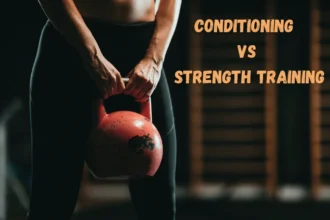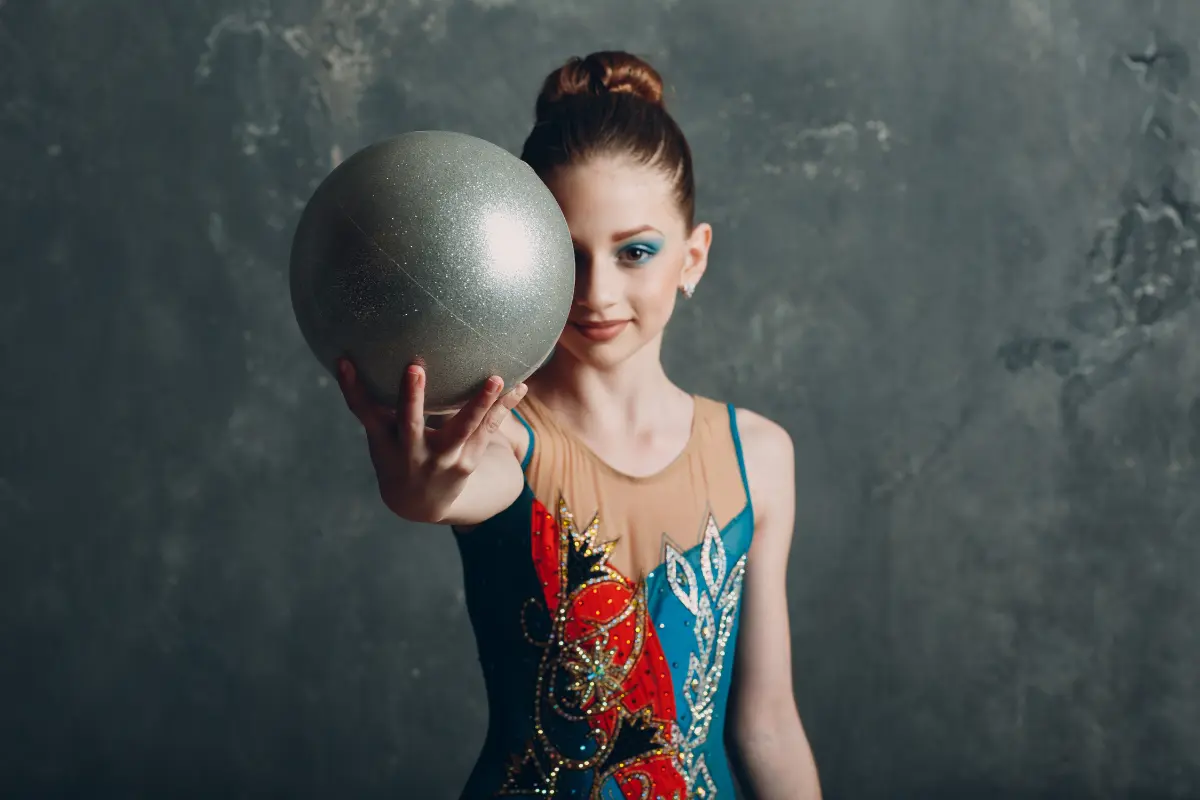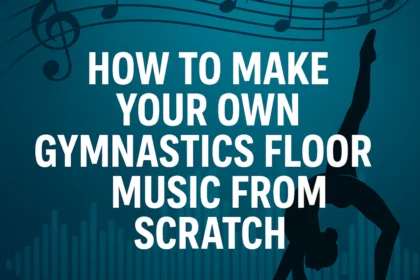Rhythmic gymnastics is a visually stunning sport that combines artistry, flexibility, and strength. Unlike other forms of gymnastics, it focuses on using various apparatus to express creativity while performing coordinated, dance-like routines to music.
There are five primary apparatus used in rhythmic gymnastics: the hoop, ball, clubs, ribbon, and rope (which is no longer part of senior competitions). Each of these tools requires skill, coordination, and creativity to master.
Here’s a simplified version of the table:
| Apparatus | Difficulty | Key Features | How to Use |
|---|---|---|---|
| Ribbon | 5/5 | Long, lightweight | Swing, twirl, toss, and catch while moving gracefully |
| Clubs | 4.5/5 | Small, used in pairs | Toss, catch, spin, and pass between hands |
| Hoop | 4/5 | Circular | Roll, toss, balance inside, and combine with body movements |
| Ball | 3.5/5 | Soft, round | Roll, bounce, toss, and combine with dance moves |
| Rope | 3/5 | Rope (historically used) | Jump, twirl, toss, and control while moving |
Ribbon
The ribbon is one of the most iconic and visually stunning apparatus in rhythmic gymnastics. It captures the audience’s attention with its fluid and graceful movements, creating beautiful, sweeping patterns in the air.
Features:
- Length: Typically 6 meters for senior gymnasts and 4 meters for juniors.
- Material: Made of lightweight fabric (often silk or a similar material) to allow for smooth and flowing movements.
- Stick: The ribbon is attached to a stick, usually about 50 cm in length, which is used to manipulate the ribbon during the routine.
Difficulty Rating: 5/5
How to Use:
The gymnast uses the stick to control the movement of the ribbon, creating a variety of shapes and patterns. The ribbon should appear to flow effortlessly, maintaining a continuous motion as the gymnast moves. Key movements include:
- Swinging and Twirling: The gymnast swings the ribbon in large, graceful arcs to form circular and spiral patterns.
- Tossing and Catching: The gymnast tosses the ribbon into the air, creating sweeping arcs, and catches it without disrupting the flow of the routine.
- Fluid Movements: Gymnasts integrate the ribbon into their choreography, performing jumps, turns, splits, and balances while keeping the ribbon in motion. Every move must be synchronized with the gymnast’s body movements and the rhythm of the music.
The ribbon is considered the most difficult apparatus in rhythmic gymnastics due to the high level of skill and artistry required to perform it effectively. The combination of athleticism, coordination, and creativity makes it a standout feature of the sport.
Clubs
The clubs are another key apparatus in rhythmic gymnastics, known for their dynamic and fast-paced nature. This apparatus requires extreme coordination, precision, and agility, making it one of the more challenging tools in the sport.
Features:
- Length: Typically around 40 cm for senior gymnasts.
- Material: Made from plastic or wood, with a bulbous end, which helps maintain the balance when they are spun.
- Used in pairs: Gymnasts use two clubs at once, which adds complexity to the movements.
Difficulty Rating: 4.5/5
How to Use:
The gymnast uses both clubs simultaneously, incorporating them into fast, intricate movements. The challenge is maintaining control and synchronization between both clubs while performing other body movements. Some key techniques include:
- Tossing and Catching: Gymnasts toss the clubs into the air, often executing multiple spins before catching them. The clubs must be caught with perfect timing.
- Spinning and Twirling: The clubs are twirled, spun, and passed from hand to hand in smooth, rhythmic patterns. They can be spun in circles, figure eights, or other complex patterns, all while keeping the rhythm of the routine intact.
- Body Integration: The clubs are used in combination with body movements like jumps, turns, splits, and balances. The gymnast often incorporates a variety of acrobatic and dance elements while handling the clubs, making the routine dynamic and visually striking.
The clubs are one of the most challenging apparatus in rhythmic gymnastics because they require both agility and precision. Mastery of the clubs demands high levels of coordination, strength, and timing, as gymnasts perform fast, complex routines while maintaining complete control over both clubs.
Hoop
The hoop is one of the most classic and widely recognized apparatus in rhythmic gymnastics. It is often associated with elegance and precision, requiring gymnasts to demonstrate their control, balance, and coordination.
Features:
- Diameter: Typically 80-90 cm for senior gymnasts and slightly smaller for juniors (70-80 cm).
- Material: Usually made of plastic, which allows it to roll smoothly and maintain its shape.
- Shape: The hoop is circular, which makes it ideal for rolling and performing acrobatic elements.
Difficulty Rating: 4/5
How to Use:
The hoop is incredibly versatile and can be used in a variety of ways within a gymnast’s routine. Some of the key techniques include:
- Rolling: The gymnast rolls the hoop along their body or across the floor. This could involve rolling it on their arms, legs, or even neck. The challenge here is maintaining control while keeping the hoop in motion.
- Tossing and Catching: Gymnasts toss the hoop into the air, performing spins or acrobatic movements while the hoop is in mid-flight, and then catch it with precise timing.
- Balancing: Some routines involve the gymnast balancing inside the hoop or holding it while executing complex movements like splits or leaps. This requires balance and body control, especially when integrating other acrobatic skills.
- Incorporating Body Movements: The gymnast integrates the hoop with other movements like jumps, turns, and floor exercises. The hoop should remain a seamless part of the gymnast’s choreography, appearing as an extension of their body.
The hoop is a fascinating apparatus because it combines technical skill with artistry. Gymnasts must balance precision, coordination, and creativity to create routines that are not only technically impressive but also visually captivating.
Ball
The ball is one of the most accessible and visually engaging apparatus in rhythmic gymnastics. Despite being simpler in appearance compared to the ribbon or clubs, it still requires a high level of coordination, precision, and creativity to use effectively in routines.
Features:
- Diameter: Typically 18-20 cm in diameter.
- Material: Soft and pliable, often made from rubber or a similar material that allows it to bounce and roll smoothly.
- Shape: Round and smooth, designed to roll, bounce, and be controlled easily during routines.
Difficulty Rating: 3.5/5
How to Use:
The ball is used in a variety of ways, with the gymnast needing to keep it in constant motion while performing acrobatic and dance movements. Some key techniques include:
- Rolling: The gymnast rolls the ball along their body (such as over their arms, back, or legs) or on the floor. This requires control and smoothness, as the ball must roll at a steady pace without falling off course.
- Bouncing: The gymnast bounces the ball on the floor, keeping it in motion while integrating other movements. The challenge is to control the ball’s bounce, making sure it stays in sync with the gymnast’s body movements.
- Tossing and Catching: Like the hoop and ribbon, the ball is often tossed into the air, and the gymnast must catch it while continuing to perform their routine. The toss can be integrated with jumps, spins, and other acrobatic elements.
- Body Integration: The ball is frequently incorporated into various body movements, such as jumps, splits, or balances. The gymnast may roll or toss the ball while performing these moves, adding complexity and elegance to the routine.
The ball is an essential apparatus in rhythmic gymnastics because it allows gymnasts to demonstrate both technical skill and artistry. While it may not be as difficult as the ribbon or clubs, it still requires excellent coordination and control.
Rope (Discontinued)
The rope was once an essential apparatus in rhythmic gymnastics but is no longer part of modern international competitions. It was used for a variety of acrobatic and skill-based elements, but its inclusion in routines has been replaced by the more dynamic apparatus we see today.
Features:
- Length: Varies depending on the gymnast’s height, but generally long enough for the gymnast to perform jumps and tricks while manipulating it.
- Material: Typically made from cotton or synthetic fibers, offering enough flexibility to be twirled or spun in the air.
- Shape: A long, flexible string-like object that can be swung, tossed, or twirled.
Difficulty Rating: 3/5
How to Use:
The rope was used in rhythmic gymnastics routines for a range of movements that combined coordination, agility, and strength. Some of the key techniques included:
- Jumping: One of the primary uses of the rope was for skipping or jumping over it, much like in a traditional skipping rope routine. The gymnast would either jump over the rope as it was swung or manipulate it in such a way that it added to the rhythm of the routine.
- Twisting and Spinning: The rope could be swung and twisted in various directions, creating shapes and patterns in the air. The gymnast would twirl it around their body or throw it into the air and catch it again, requiring great precision and timing.
- Acrobatic Moves: Gymnasts often performed acrobatic movements, such as jumps, flips, or rolls, while managing the rope. This added a dynamic element to the routine, as the gymnast had to coordinate their movements with the rope’s position.
- Tossing and Catching: Similar to the ribbon, the rope could be tossed into the air and caught while the gymnast continued to perform their routine. This required exceptional timing and coordination.
Although the rope is no longer part of competitive rhythmic gymnastics, it remains an important part of the sport’s history. The unique challenges it posed – such as timing, coordination, and control – made it an excellent apparatus for demonstrating the skill and athleticism required in rhythmic gymnastics.













